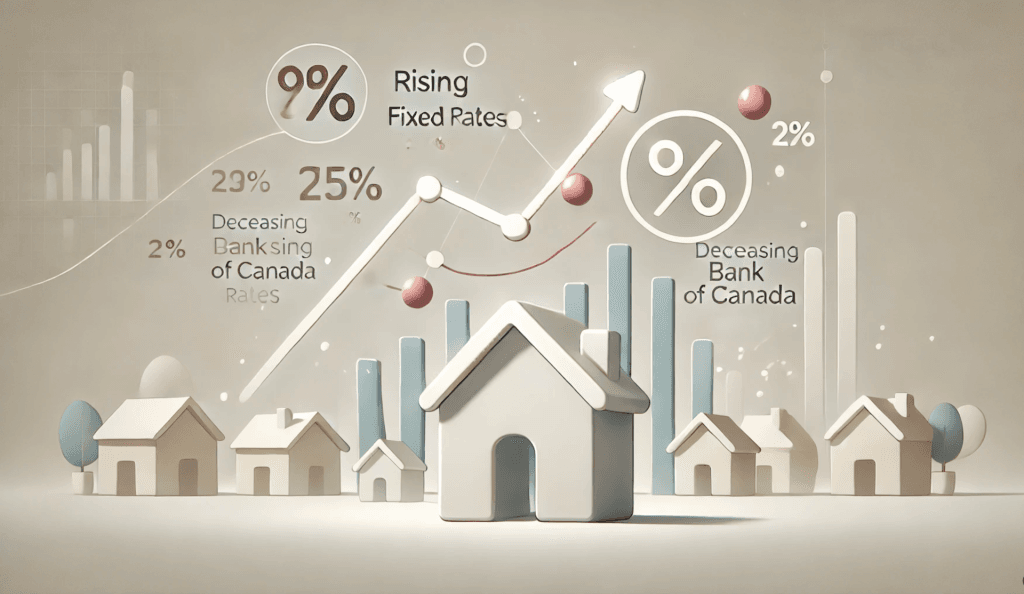Let’s Talk Mortgage Rates: Why Are Fixed Rates Going Up While the Bank of Canada Is Cutting Rates?

Wait, what? The Bank of Canada is lowering rates, but fixed mortgage rates are still on the rise? It seems like a contradiction. If you’re wondering how that’s possible, you’re in the right place. In this blog post, we’re pulling back the curtain on how the bond market plays a key role in shaping fixed rates—even when the Bank of Canada is trying to make borrowing cheaper. Let’s dig into the details and clear up the mystery together!
Summary of the Bank of Canada Rate and Its Effect on Mortgage Rates
The Bank of Canada’s overnight lending rate and the bond market are connected but operate independently.
Changes in the Bank of Canada’s rate do not always lead to immediate changes in fixed mortgage rates. Here’s a breakdown of how it all works:
The Bank of Canada’s Overnight Rate:
- What it is: This is the interest rate at which the Bank of Canada lends money to commercial banks, like RBC, on a short-term basis.
- How it works: When the Bank of Canada changes its overnight rate, it directly affects variable interest rates, like those on variable-rate mortgages, lines of credit, and certain credit cards.
- Not the consumer rate: Even if you hear that the overnight rate is dropping to 2.75%, which is the long-term expectation, this isn’t the rate consumers receive on their mortgages. Banks will add a markup when they lend to consumers. Consumers receive the Prime Rate minus the discount or, in some cases, a premium.
The prime rate in Canada is the interest rate banks use as a starting point to set interest rates for loans, like variable-rate mortgages, lines of credit, and business loans. Here’s how it’s determined in simple terms:
Starts with the Bank of Canada’s Overnight Rate:
- The prime rate is based on the Bank of Canada’s overnight rate, which is the interest rate that banks pay when they borrow money from each other or from the Bank of Canada, usually for short-term loans.
- When the Bank of Canada changes its overnight rate, it’s like setting a guideline that influences what banks charge their customers.
Banks Add a Markup:
- To turn the overnight rate into the prime rate, banks add a bit of a cushion (usually around 2% to 2.25%) to cover their costs and ensure they make a profit.
- For example, if the Bank of Canada’s overnight rate is 2.75%, most banks will set their prime rate at around 4.75% or 5.0%.
All Banks Follow the Same Trend:
- Although each bank technically sets its own prime rate, they all tend to move in lockstep with the Bank of Canada’s rate changes. So when the Bank of Canada raises or lowers its rate, most banks adjust their prime rates in the same way, almost immediately.
Why the Prime Rate Matters:
- The prime rate acts as the base rate for many loans, meaning when it goes up or down, the interest rates on things like variable-rate mortgages and lines of credit also change.
- If you have a loan that is “prime plus” or “prime minus,” it means the interest rate you pay will be the prime rate plus or minus a certain percentage, depending on the terms of your loan.
In a Nutshell:
The prime rate in Canada is calculated by taking the Bank of Canada’s overnight rate and adding a standard markup of about 2% to 2.25%. This rate is used as a benchmark by banks to set interest rates for various loans, and it changes whenever the Bank of Canada adjusts its overnight rate.
Fixed Rates and the Bond Market:
- Independent of the Bank of Canada’s Rate: Fixed mortgage rates are mainly influenced by the bond market, not directly by the Bank of Canada’s overnight rate.
- Bond Yield Movements: Even if the Bank of Canada lowers its rate, fixed mortgage rates might stay the same or even increase if bond yields rise.
- Why Bond Yields Rise: Rising bond yields can be due to concerns about inflation, global market trends, or other economic factors that don’t necessarily align with the Bank of Canada’s moves.
Impact on Borrowers:
- Variable Rates: When the Bank of Canada’s rate changes, it directly affects variable-rate mortgages and lines of credit, which can have a significant impact on businesses and individuals carrying large amounts of debt.
- Fixed Rates: These aren’t immediately affected by the Bank of Canada’s rate cuts or hikes but follow trends in the bond market, which can sometimes move in the opposite direction.
Key Takeaways:
- Bank of Canada rate drops don’t guarantee lower fixed mortgage rates.
- Fixed rates depend on bond yields, which can rise or fall due to different factors – currently, its the US market that is influencing the increase in the fixed rates, even though the BoC rate is decreasing.
- Variable/Adjustable lines of credit and some credit cards rates react more directly to the Bank of Canada’s overnight lending rate changes.
Understanding Bond Yields and the Fixed Rate Mortgage
The bond market plays a big role in determining fixed mortgage rates in Canada. Here’s how it works in simple terms:
1. Fixed Mortgage Rates and Bonds Are Connected:
- Fixed mortgage rates are closely tied to the rates of Canadian government bonds, especially 5-year bonds.
- When bond yields (the interest rates that bonds pay) go up, fixed mortgage rates tend to go up too. When bond yields go down, fixed mortgage rates usually go down.
2. Why Bond Yields Change:
- Investor Demand: If investors are nervous about the economy, they often buy more bonds because they’re seen as a safe investment. High demand for bonds drives the yields down, which can lead to lower fixed mortgage rates.
- Economic News and Inflation: If inflation is rising or the economy is strong, bond yields usually go up. This is because investors want a higher return on their money to keep up with inflation, which means fixed mortgage rates might also increase.
3. Banks and Lenders Follow Bond Yields:
- Lenders watch the bond market closely because it helps them decide how much it will cost them to lend you money for a mortgage.
- When bond yields go up, it costs more for lenders to borrow money, so they raise their fixed mortgage rates to cover those costs. When yields go down, lenders can afford to lower fixed rates.
Putting It All Together:
Think of bond yields as a temperature gauge for fixed mortgage rates. When the bond market gets hotter (yields rise), fixed mortgage rates tend to go up. When the bond market cools down (yields fall), fixed mortgage rates usually drop as well.
So, the bond market acts as a guide for lenders when setting fixed mortgage rates. Changes in investor demand and the economy directly affect bond yields, which then influence the rates you see when you’re shopping for a mortgage.
